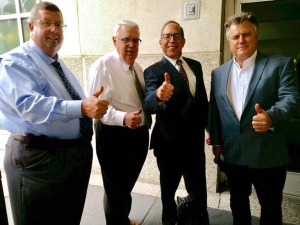PUT DATA TO WORK FOR YOUR BUSINESS
David Libesman, TEAM Software by WorkWave, CALSAGA Network Partner
Data has become increasingly important in business, as major companies are devoting more time and energy into tracking, finding and understanding how to make informed decisions. With data, businesses have the power to expose inefficiencies, highlight opportunities, shed light on customer trends and improve daily operations.
Companies that use data properly have the power to turn valuable information into hard stats or raw analytics that provide insights that can increase profitability. Though the security industry has its nuances, business owners can take steps to gain an edge over competitors.
Placing value on data
Without careful processing in the correct context, data can appear unorganized at first glance. Data must be organized and interpreted to have tangible value and then communicated effectively to ensure that insights can be obtained even from professionals unfamiliar with raw data to put the information into context.
Data pertaining to service costs, market conditions and labor requirements can offer insights into how much a customer is willing to charge for security services. Activity data related to schedules, service completions and performance can help denote quality workers who may be ready for additional responsibilities. Operational data that focuses on tracking response times, team productivity and measuring assessments can help optimize operations.
Turning data into insights
Because companies have the power to access deep insights and drive significant business value when their data is accessible and integrated, it must be transformed into information. After data is collected and gathered from various sources, it must be reviewed and assessed for accuracy, curated and normalized before it can be utilized as actionable information.
Different data sets need to be integrated from various sources and ensure the view is unified and connections can be made across teams. Then the data can be analyzed with the goal of discovering useful information – this is where patterns and trends can be identified. Finally, the data must be presented in a format that can be easily digested by various employees of different backgrounds, so the information may be put to actionable use.
In its final stage, data can help professionals make informed decisions on how to move forward. Data aids with exposing inefficiencies while revealing opportunities for confident business decisions. If the right actionable insights are taken, a business may be able to use data to achieve scalable business growth without requiring additional support.
Actionable data insights
Data can be used for auditing purposes, to track the quality of services to ensure operations are fully optimized. Businesses can use data to better evaluate whether the services being offered are upheld to the specifications of SLAs. Alternatively, data can highlight possible expenses that can be cut, allowing for a security company to have additional confidence in taking those steps.
Customer behavior can be better understood, as data can highlight consistent actions, which can aid in retaining and encouraging repeat business. Data can be used jointly with customers to help them better understand the guard services provided and how steps are being taken to reach specific standards.
Analyzing and interpreting data can enhance financial performance and boost profitability. For example, reviewing previous client contracts and using that information to prepare for future business can help businesses recognize trends and focus on profitable services.
TEAM Software and data
TEAM Software understands how critical information is to the security sector. To continue supporting security professionals, we’ll soon launch analytics tools with new capabilities to help support business growth. When these tools are ready for use, more information will be available on the teamsoftware.com website.
David Libesman, SVP & GM, AI& Data Analytics Business Unit at WorkWave
David Libesman is a visionary SaaS executive with an entrepreneurial spirit and track record of developing, monetizing and growing data analytics & AI product strategy and business. David is well-versed in driving strong sales through enterprise channels, as well as building, developing and retaining high-performing teams. He aims to bring best of breed AI and analytic capabilities to boost growth and profits for TEAM Software customers through data-driven strategies.







 JoJo Tran is Chief Executive Officer of Telepath Corporation. Tran joined Telepath in 1990 and became CEO in September 2010. Previously, he headed several business units at Telepath, including mission critical infrastructure, customer service, sales and mobile team. Mr. Tran’s vision is to be the industry’s premier sales, service and program management company. Customers and partners will see Telepath as an integral to their success. Telepath will anticipate their needs and deliver on every commitment. People will be proud to work at Telepath. Telepath will create opportunities to achieve the extraordinary and will reward their success.
JoJo Tran is Chief Executive Officer of Telepath Corporation. Tran joined Telepath in 1990 and became CEO in September 2010. Previously, he headed several business units at Telepath, including mission critical infrastructure, customer service, sales and mobile team. Mr. Tran’s vision is to be the industry’s premier sales, service and program management company. Customers and partners will see Telepath as an integral to their success. Telepath will anticipate their needs and deliver on every commitment. People will be proud to work at Telepath. Telepath will create opportunities to achieve the extraordinary and will reward their success.

 Debbie Howlett
Debbie Howlett